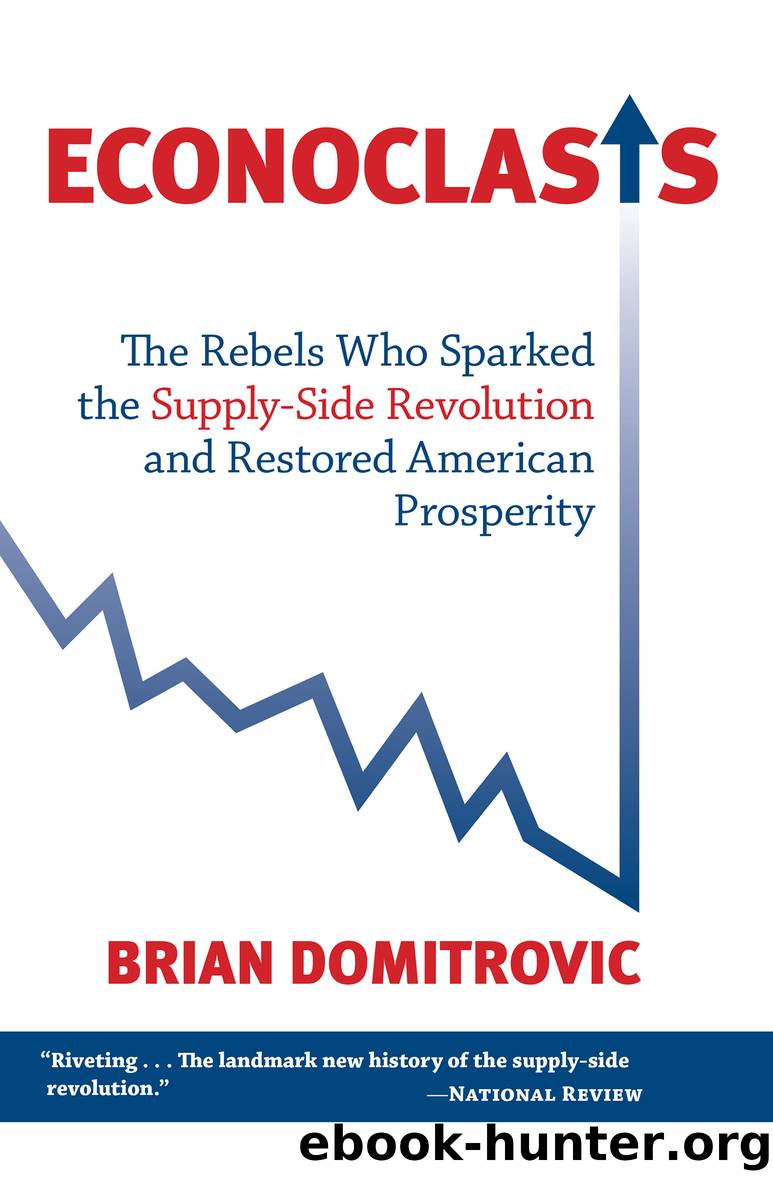Econoclasts by Brian Domitrovic

Author:Brian Domitrovic
Language: eng
Format: epub
Publisher: Regnery Gateway
Published: 2023-10-03T00:00:00+00:00
Americaâs Next Top Models
The matter of doing something remained. This is where Kemp hit his stride. All over the country in 1979, he spoke words such as these, delivered to an audience in New York City: âWe have seen a total reversal of economic thoughtâ¦. Conservatives are in the midst of a tremendous debate as to which way to go, whether they should go back to their austerity model or whether they should go where Bill Roth, Bill Steiger, Jack Kemp, Art Laffer, Robert Mundell, the pages of the Wall Street Journal, Public Interest, and some radical economists on the Street, as well as some radical young economists in academia are suggesting: toward growth, production, incentives for both labor and capital.â43
Even Congress, despite the rules change, was coming around. The Joint Economic Committee (JEC), whose main responsibility to date had been commenting on the presidentâs annual economic report, announced in March that for the first time in twenty years it had a unanimous report of its own. The reason for the unanimity: all were agreed on the necessity to âforce the attention of the country and its economic experts on the supply side of the economy.â44
The Democrats and Republicans on the JEC, whose chairman was Lloyd Bentsen, were not quite prepared to endorse Kemp-Roth, excluding John Rousselot. But all were ready to talk about the operative word of supply-side economics: âincentives.â The report called for a business-tax cut. It stressed that economic capacity and production would increase as a result. It also offered a menu of spending programs, job-retraining initiatives, and such that the majority felt qualified as incentives in the real economy. Rousselot and other supply-side-minded members smiled at this but signed on anyway. It had become apparent that the necessity of tax cuts would become obvious soon enough.
As for why the JEC wanted to âhelp hold down the cost of living by increasing the goods on the shelves of the Nationâs businessesââthe language of the report and a summary of the supply-side solution to stagflationâit was not because all members were distressed by the 1970s funk. Certain members, such as Bentsen, had long track records of demanding that the government let business produce more. But others, such as Edward M. Kennedy and George McGovern, belonged to the John Kenneth Galbraith school of thought, which held that the nation already produced enough. Paul Craig Roberts, in his memoir, speculated on why Kennedy in particular, along with other âbig spendersâ in Congress, was willing to sign the JEC report and clear the pathway for supply-side reform. âThe spenders had been handing out⦠money faster than the economy could generate tax revenues and were worried about their programs running dry,â he concluded. Roberts thus implied that in their secret hearts, big-government types believed that supply-side economics would succeed not only in promoting growth, but also in increasing government revenues.45
The JEC report marked the end of a certain kind of congressional rhetoric. In his memoir, Roberts compiled an anthology of the sophisms that supply-side advocates had had to contend with routinely in the halls of Congress through 1978.
Download
This site does not store any files on its server. We only index and link to content provided by other sites. Please contact the content providers to delete copyright contents if any and email us, we'll remove relevant links or contents immediately.
The Secret History by Donna Tartt(16699)
The Social Justice Warrior Handbook by Lisa De Pasquale(11501)
Thirteen Reasons Why by Jay Asher(7821)
This Is How You Lose Her by Junot Diaz(5813)
Weapons of Math Destruction by Cathy O'Neil(5065)
Zero to One by Peter Thiel(4854)
The Myth of the Strong Leader by Archie Brown(4803)
Promise Me, Dad by Joe Biden(4465)
Beartown by Fredrik Backman(4454)
How Democracies Die by Steven Levitsky & Daniel Ziblatt(4437)
Stone's Rules by Roger Stone(4431)
The Fire Next Time by James Baldwin(4360)
100 Deadly Skills by Clint Emerson(4100)
A Higher Loyalty: Truth, Lies, and Leadership by James Comey(4049)
Rise and Kill First by Ronen Bergman(4034)
The David Icke Guide to the Global Conspiracy (and how to end it) by David Icke(3902)
The Farm by Tom Rob Smith(3887)
Secrecy World by Jake Bernstein(3798)
The Doomsday Machine by Daniel Ellsberg(3745)
